3 Best Ways to Backup Your WordPress Website

Imagine waking up ready to publish a new blog post only to discover that your prized WordPress site has vanished.
Poof! All of your posts, pages, themes, and customizations are gone!
So, to ensure the safety of your website content and peace of mind, backup your WordPress website regularly. While it sounds crazy, WordPress disasters happen more than you’d think.
As the CMS behind 43% of all websites, WordPress is a prime target for cybercriminals. But even without a hack, accidental deletion, server errors, and glitches can wipe out your site.
Luckily, a solid WordPress backup plan saves you when catastrophe strikes. Regular backups are a safety net, whether automated, manual, or through your host.
Keep reading to explore the best ways to backup your WordPress site.
Why Backup Your WordPress Website?
Losing your site means missing out on traffic, leads, sales, and visibility. Unfortunately, most website owners never consider backing up their site data until necessary.
It’s never too late if you have a live website. Beyond recovery, backups give you version control to:
- Identify security issues or malware to restore uninfected files.
- Satisfy regulatory compliance on data retention. Backups facilitate compliance during audits.
- Clone or migrate your website to develop locally or change hosting providers.
- Revert to a previous version of the website after a bad edit or failed update.
When Should You Backup your WordPress Site?
How often should you back up your website? It depends.
If you rarely update your site, like a portfolio that changes every few months, you don’t need backups as often. But hourly backups may be best if it’s a news site with minute-by-minute updates.
Web hosts offer hourly, daily, or weekly plans. Daily may be the sweet spot—frequent enough to stay current but not aggressive overkill.
The rule of thumb? Backup as often as your site changes. Daily backups catch all the updates, so you always have a recent version to restore.
1. How to Backup Your WordPress Site Manually
Many hosts offer automated backups. But having copies in an easy-to-access spot gives you control to backup your WordPress website whenever you want.
With manual methods, there’s no limit on storage or relying on someone else’s schedule. You can download copies of all custom files and databases to store externally. This saves you if your host fails—you can quickly relaunch your site.
There are two manual backup methods:
- Manual file backup
- Manual database backup
Manual WordPress Website File Backup Process
Before jumping in, a quick note— all your site’s files live together in folders on your web hosting account, usually in public_html or something similar.
This directory contains everything making up your site—WordPress core, plugins, themes, uploads, and more.
A manual backup means copying these WordPress folders and files elsewhere for safekeeping. You’re physically downloading a full snapshot of your site.
Heads up, though—manual backups gobble up server resources. So, your site may feel temporarily sluggish during the process. That’s why many folks use set-it-and-forget-it backup plugins instead.
But you can pull off manual WordPress backups using these options:
- Through cPanel: Your hosting provider’s control panel lets you directly access and copy site files. Pretty simple if you know where to click.
- Using FTP: This nerd protocol also opens up file access for transfers. A bit more complex to get grips with, though.
Let’s explore both cPanel and FTP manual backup methods step-by-step now…
Method 1: Backup Your WordPress Website Using cPanel
The cPanel is a beginner-friendly method of backing up your website files. However, some web hosting companies don’t use cPanel, so affected site owners may want an alternative option.
Here’s a step-by-step guide to this method:
1. Accessing the cPanel: First, you must access your hosting provider’s cPanel dashboard.
Normally, the web host provides a link to input your login details. It gives you access to a graphical interface to manage your hosted files.
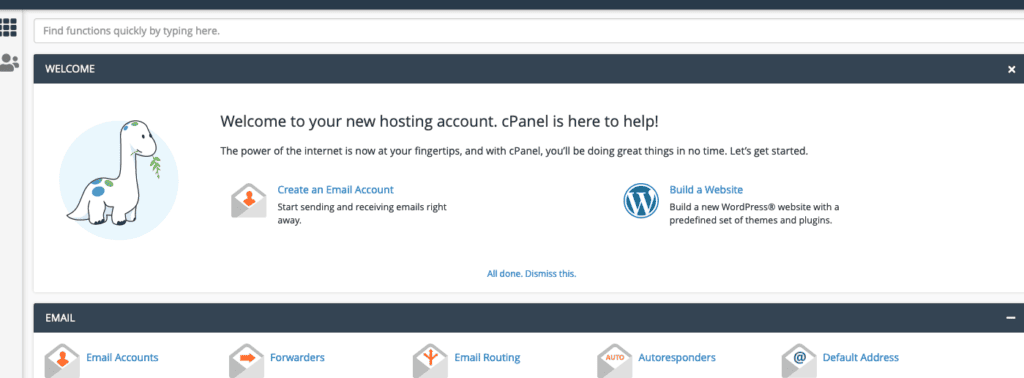
2. Navigating your files: Once you access the cPanel, scroll down to the file section and locate “File Manager.”
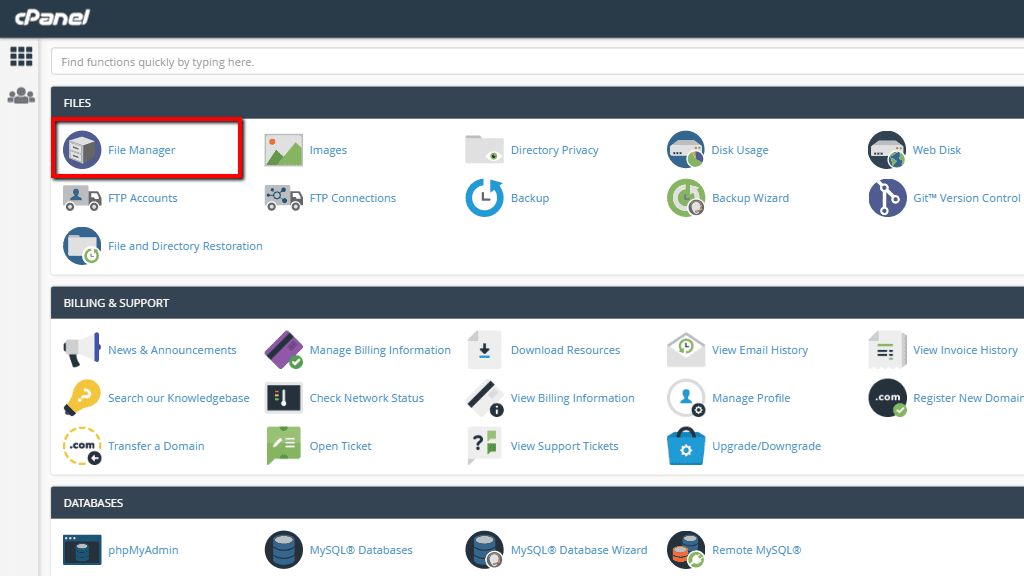
Clicking “file manager” brings you to a selection of file options. You can browse, select, compress, and download different files here.
Identify the folder named “public_html“. This folder is your web server root with all the WordPress site files.

If you have several websites on your web hosting account, you’ll see several folders under “public_html.” But if you have a single website, you’ll only see a single folder.
Click on that folder to open your website files.
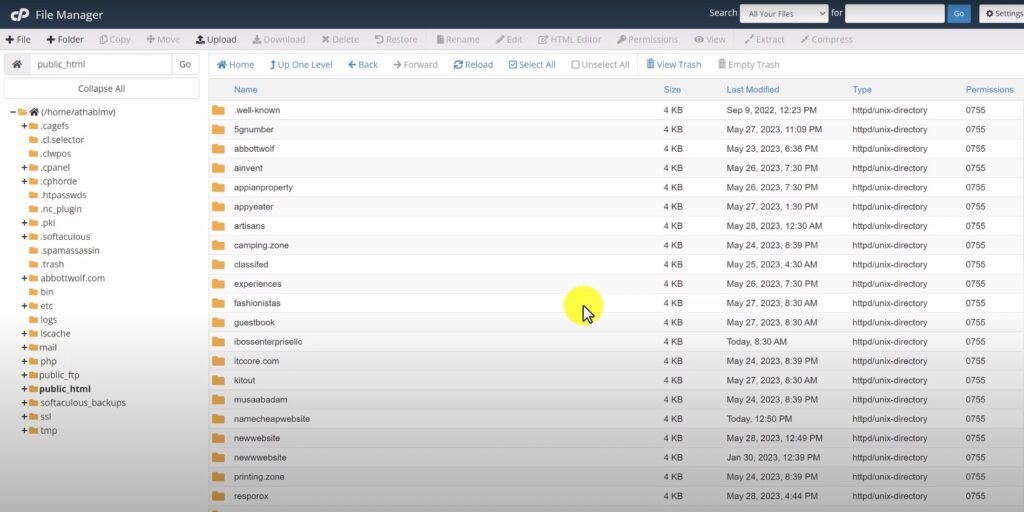
3. Compressing the files: Opening the website folder displays your website’s files. Highlight the files by clicking “Select all.”
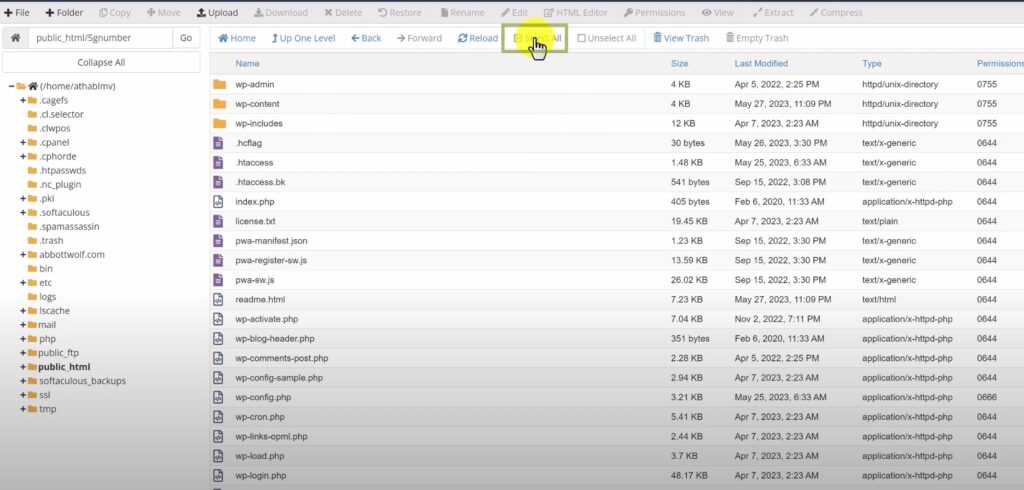
Before downloading these files, it’s best to compress them into a zip archive file before downloading. Click the “compress” tab on the top right corner of the page. A zip archive file condenses all the files into one easy package.
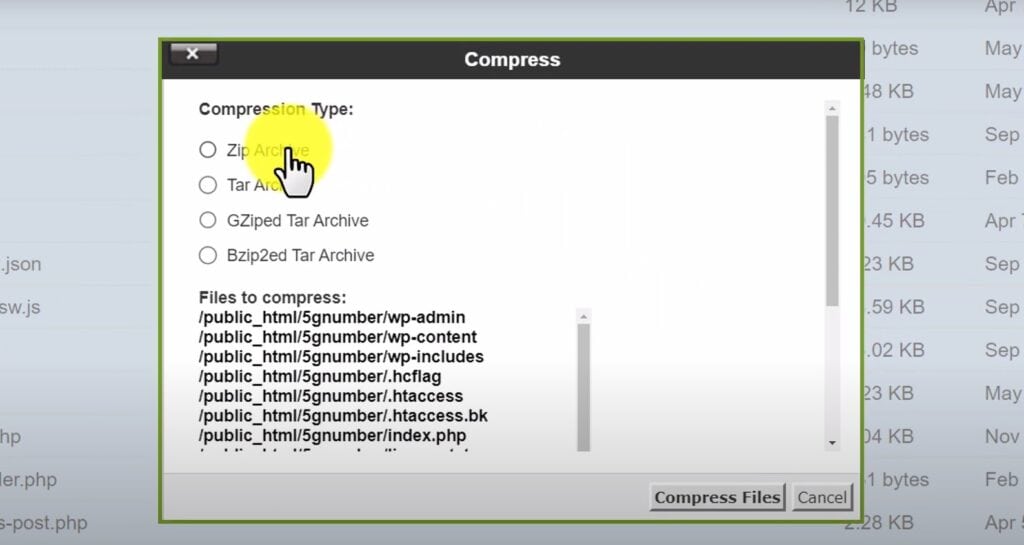
4. Downloading the backup: The process takes a few minutes. Once done, close the section and click “reload” at the top of the page. You’ll see a backup of your WordPress website files saved as “wp-admin.zip.”
Select this folder, right-click on it, and click download. You can download it directly within cPanel’s browser-based interface or link it to an offsite sync tool like Dropbox.
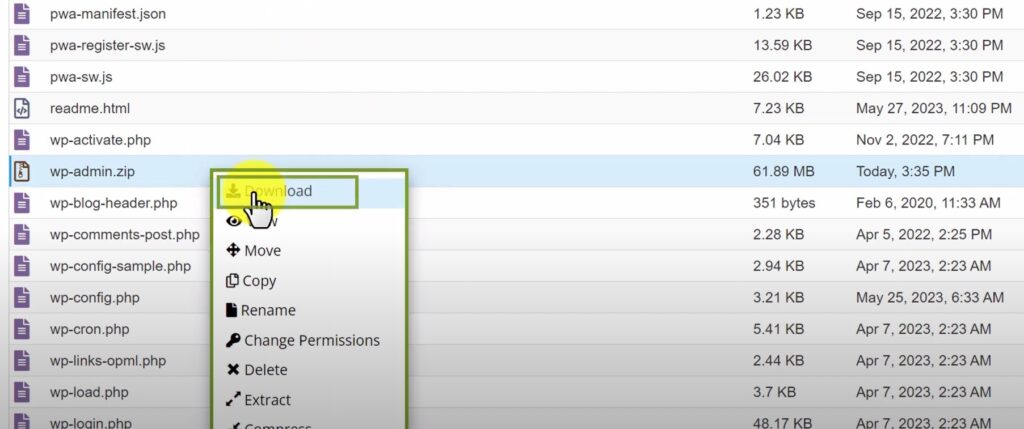
Method 2: Manually Backup Your WordPress Website Files Using FTP
An FTP Client is a software tool that lets you connect to a remote server and transfer files back and forth.
Popular FTP Clients include FileZilla, WinSCP, and Cyberduck. FTP Clients provide an interface similar to that of Windows Explorer.
1. Connect with your server: The first step is downloading your favorite FTP Client. In our case, we used FileZilla.
Once you install the FTP client, use the server credentials in your hosting control panel under “FTP Accounts” in the files section.
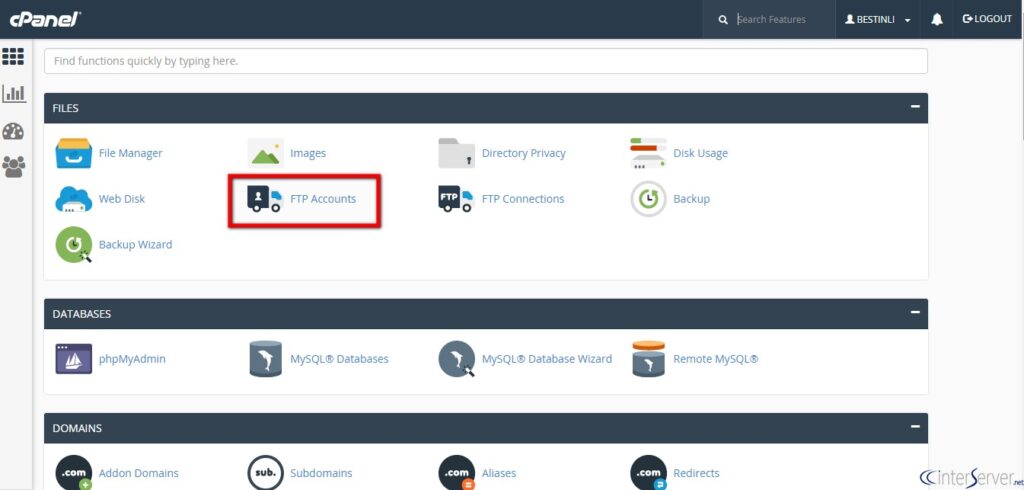
2. Navigating your files: After connecting the FTP client to the server, you can access all the files and directories. First, create a directory by selecting the “Desktop” option available on the left corner of the FileZilla interface.
Select “Create directory” and pick a suitable name like “Backup February 2024”.

3. The backup process: After creating the directory, two sections appear. One is a “Local Site,” and the other is a “Remote Site“. Go to the Local Site section and select the newly created folder. Here’s where you’ll store all the backup data.

Now, go to the Remote Site section and select your website files. Often, you’ll find them saved as “public_ftp.” Select the folder, right-click on it, and then select download.
Manual WordPress Website Database Backup
When going the manual route, you can’t backup up your WordPress website without a database. A WordPress database contains all the content, users, metadata, and settings needed for your site. Having a separate backup of the database from files is crucial.
1. Accessing the database: You can access and manage your website’s database through the cPanel under the phpMyAdmin tool. Hosting providers also offer an admin console to access the database.
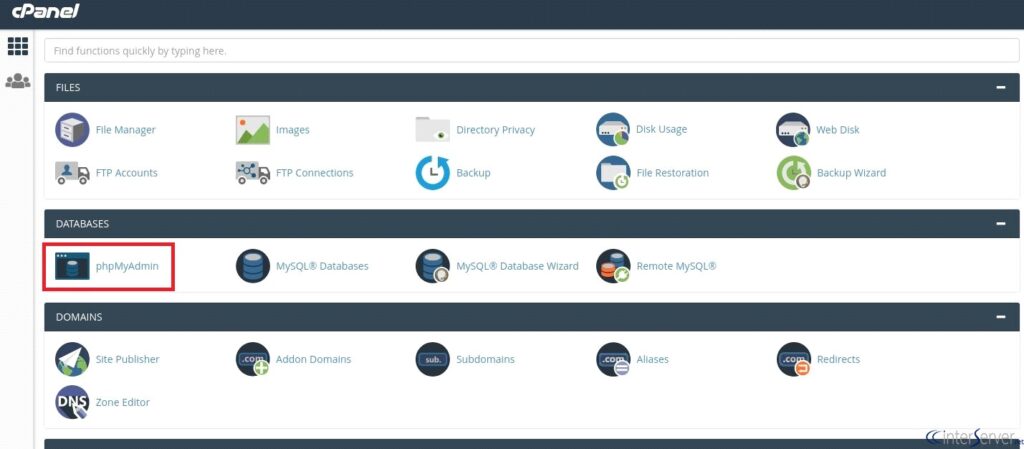
2. Locate the right database: If you have several websites, different databases will appear once you select phpMyAdmin. To locate the right database, go to public_html, then select wp-config.php.
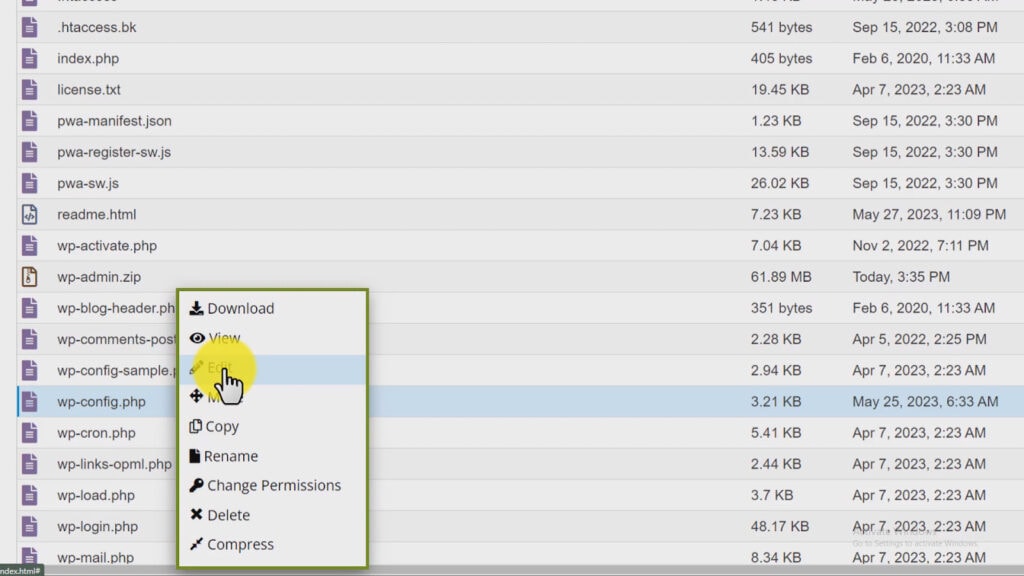
Right-click on it, choose “edit,” then confirm by clicking “edit” again. Scroll down till you find “MySQL settings.” Next to the “DB_NAME,” your database name is written in blue.
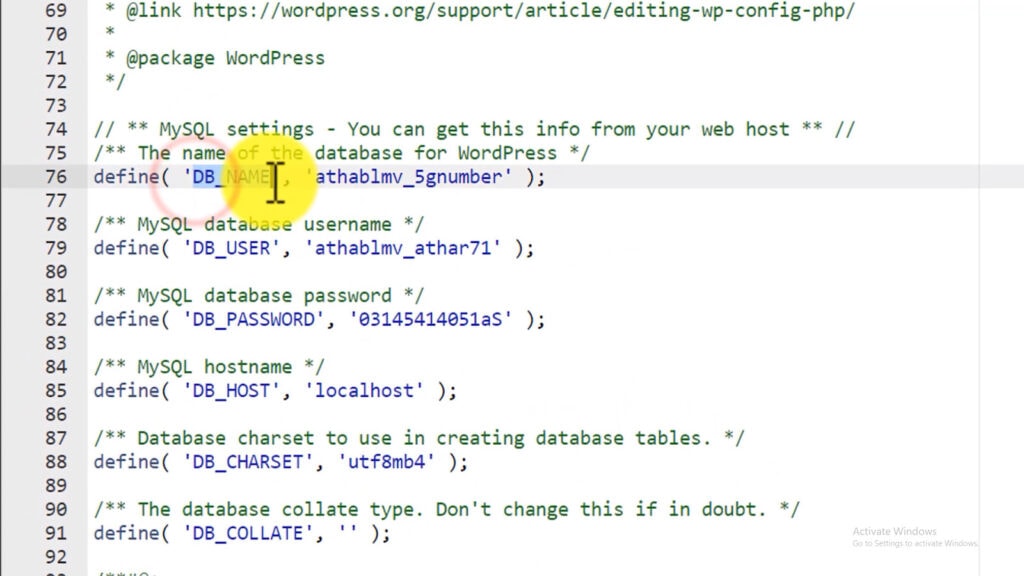
3. Export the database files: Once you find the name, you can now export the database to your local storage. Select phpMyAdmin and choose the database you found in step 2 above.
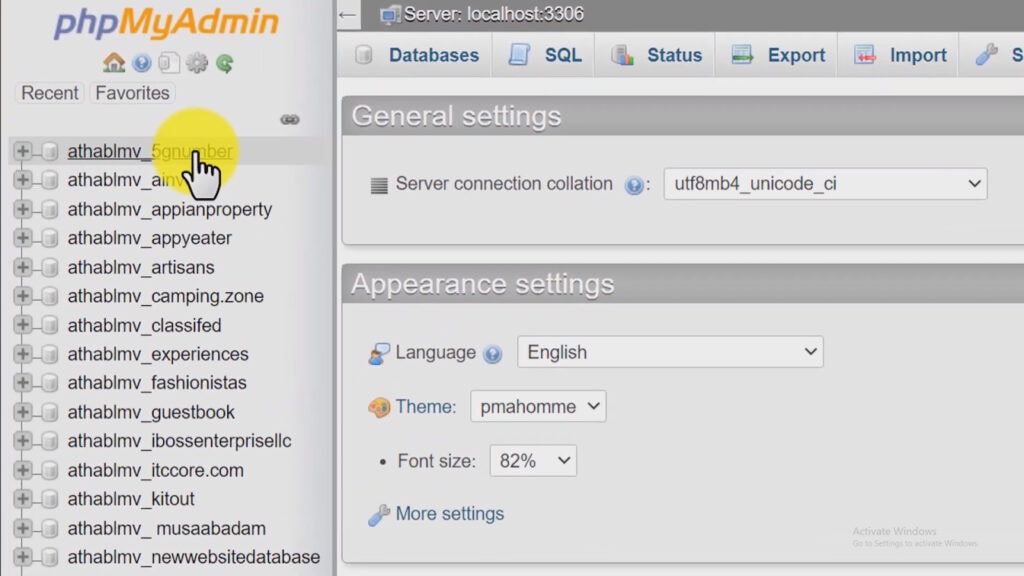
Selecting the database brings you to a screen with all the database tables. Scroll down and select “Check all“.
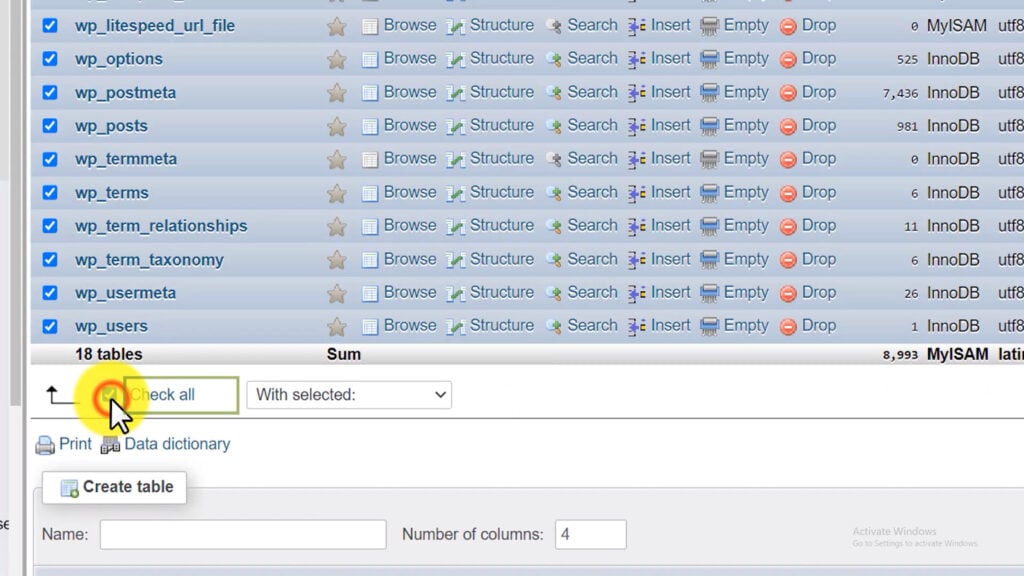
Click the next box with a drop-down, then select “Export.” Once done, click “Go,” and your website database will download on your computer.
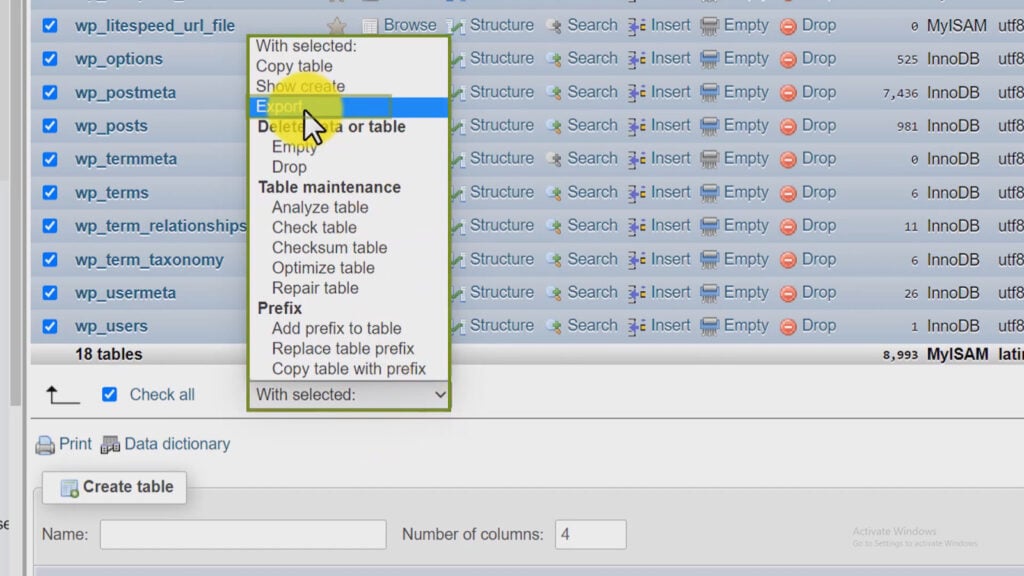
Pros and Cons of Manual WordPress Website Backup Methods
Pros
- Better control when organizing archives.
- More cost-effective than premium plugins and plans.
- Enables backup portability across hosts.
- Visibility into file-database interactions.
Cons
- Time-consuming, labor-intensive process.
- Internet disruptions and missed steps risk data corruption issues.
- It’s challenging to restore a backup system in an emergency.
2. How to Backup Your WordPress Website Automatically
Doing manual backups is better than no backup at all. But with a jammed schedule, it’s easy to space out.
An automated cloud backup system does the legwork for you, securely sending site data straight to the cloud. Some even let you restore directly from the cloud for fast recovery.
Setting up automated WordPress backups takes the stress off knowing all your site info is captured hands-free.
Plugins provide the easiest path for automatic WordPress website backups. With plugins, you can schedule regular backups of both files and the database—locally or to the cloud.
Plugins simplify the backup process through tight WordPress integration. But they also shine in their customization options.
You can choose specific files or databases to backup, set the backup frequency and retention period, and more. Most plugins also offer one-click restore, optimizing efficiency.
Popular WordPress Backup Plugins
WordPress offers hundreds of backup plugins, but a few consistently rise to the top. This overview covers the core capabilities of the top options:
1. UpdraftPlus: With over 3 million active installs, UpdraftPlus is a top option due to its wide cloud storage compatibility. It can back up files to Amazon S3, Dropbox, Google Drive, and more. The free version is fully functional; paid plans offer more features.
2. Jetpack Backups: Previously called VaultPress, Jetpack Backups emphasizes real-time backup after site changes. It’s pricey but includes security scanning, malware detection, and one-click restores.
3. Solid Backups: Ideal for site migrations, Solid Backups auto-updates themes, plugins, databases, and files. It seamlessly integrates with other plugins and themes. Paid users can manage multi-site backups.
4. BlogVault: Designed for easy site migrations and staging, BlogVault appeals to new site owners. It offers a free 7-day trial, but paid plans cost $149+ yearly.
5. BoldGrid: For existing BoldGrid users, this plugin enables fully automated backups to various cloud services. The setup is straightforward, and it coordinates with other BoldGrid tools.
Setting Up Automatic WordPress Website Backups With Plugins
Although backup plugins have varying setups, the process is straightforward. This article will demonstrate setting up automated backups using UpdraftPlus as an example.
1. Install and activate UpdraftPlus: The first step is installing UpdraftPlus. Login to your WordPress website, then select plugins. Click “Add New Plugin” and locate “UpdraftPlus” on the search bar. Once you find the plugin, click “Install Now” then “Activate“.
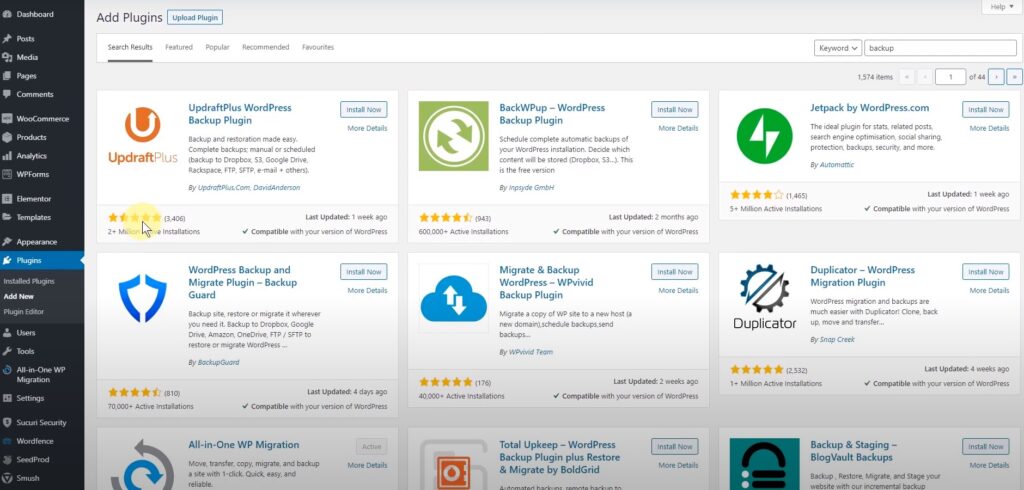
2. Configure basic backup settings: Navigate to the UpdraftPlus settings page.
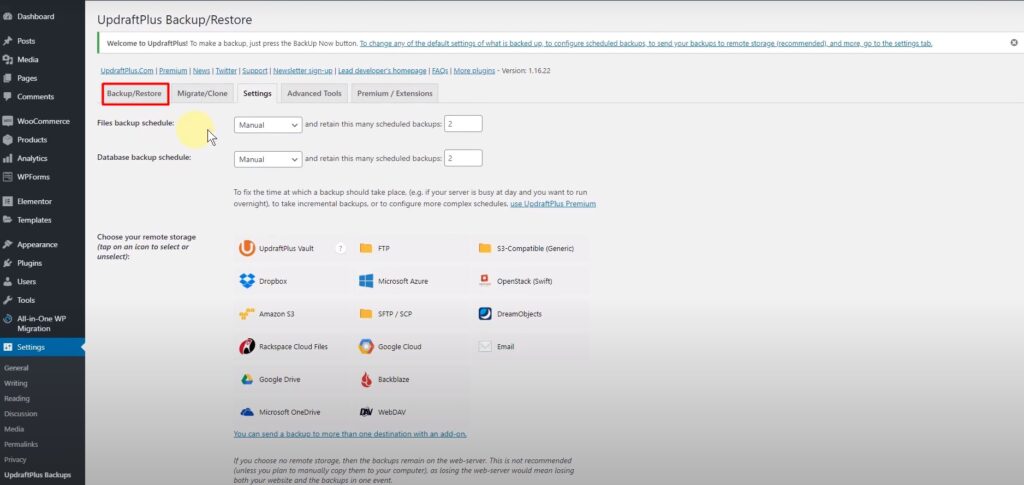
Clicking on settings will bring you to the backup page. Select “Backup Now” to create your first WordPress website backup.
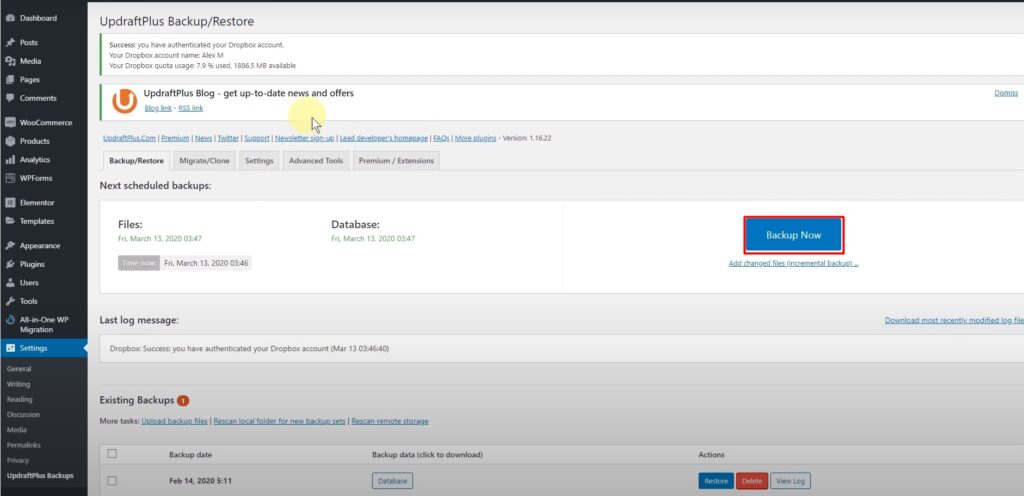
Once the backup runs, it appears on the same interface. You can download the backup as a database, themes, plugins, uploads, or other files and save them on your computer.
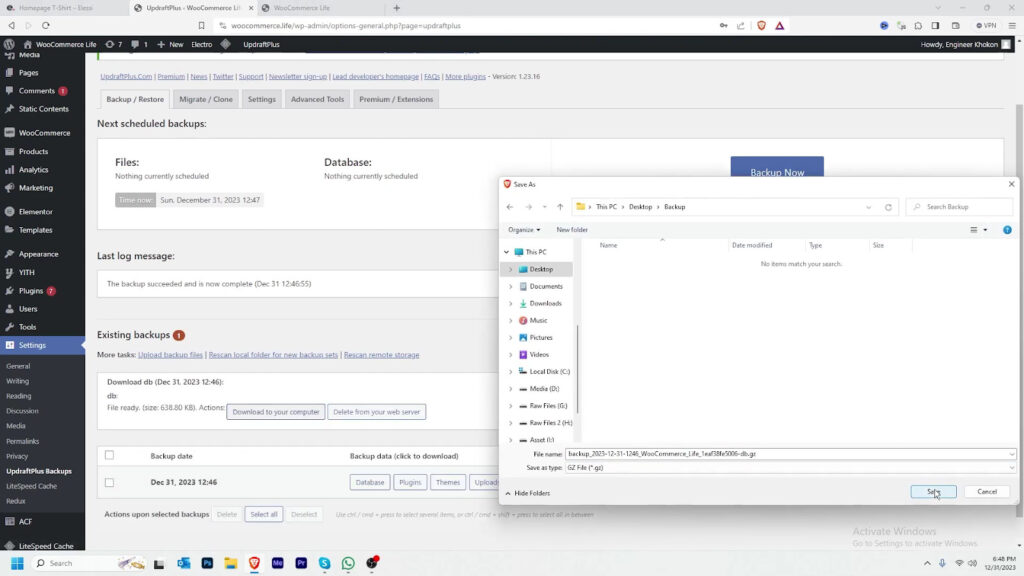
3. Select backup frequency and storage destination: The next step is to choose the frequency of your backups. You can set the backups daily, weekly, monthly, or hourly.
Once done, scroll below to select where you’ll store the backup. You choose from various options, including Google Drive and DropBox.
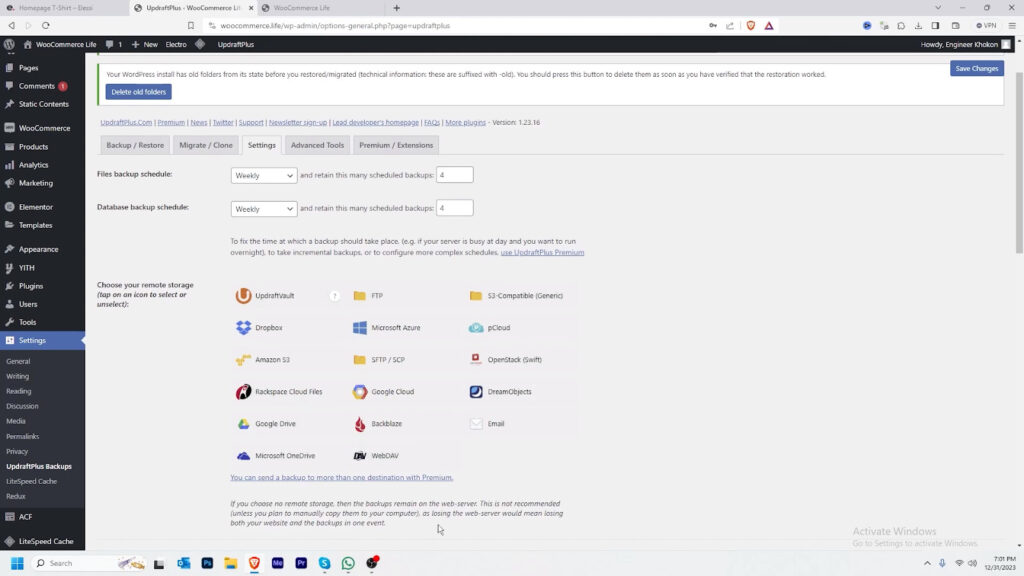
The UpdraftPlus plugin will automatically back up your WordPress website without manual intervention. Just to be sure, you can confirm if the files are available after the scheduled backup.
Pros and Cons of Automatic WordPress Website Backup Methods
Pros
- Easy setup and use.
- Some plugins include CDN and migration tools.
- It’s a completely hands-off process.
- There’s minimal impact on site performance.
Cons
- Free version plugins have limited features.
- A service provider outage will hinder the backup.
3. WordPress Website Backup Through A Hosting Provider
Backups from your hosting provider play a major role in ensuring the safety and security of your WordPress website.
While most companies include hosting as part of their plan, some are unreliable with limited features.
Some hosting companies that offer backups as part of their packages include:
- HostArmada 9.9
- KnownHost
- NameHero
- DreamHost
- SiteGround
Hosting Provider Backup Options
When evaluating backups offered by hosting providers, several factors must be remembered.
- Backup frequency: Daily backups are standard with most hosting providers, but a few companies miss out on this. One that offers multiple daily backups is ideal, especially if you run a website with constant updates.
- Retention policy: Backups consume storage spaces, and most hosting providers are sensitive about their resources. Examine how long backups are available for restoration. 30 days is standard, but one that offers 90 to 180 days is best.
- Restore capability: An ideal hosting provider should enable website owners to restore files fully via the control panel.
- Backup integrity and reporting: Partial backups on files or databases can limit your website’s functionality. A full server backup with backup logs ensures an error-free system.
Configuring Backups Through Hosting Tools
Hosting providers have varied methods for configuring WordPress backups. We’ll use SiteGround, a notable hosting company, to illustrate the backup process.
1. Access hosting tools: First, log in to your SiteGround account. Access the “Hosting Tools” on the control panel.
Select the “Backup” tool to open a new window where you can configure your settings.
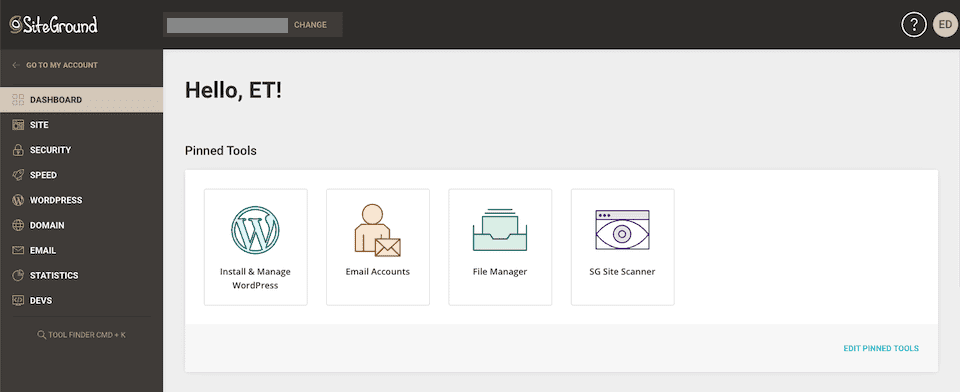
2. Review backup settings: SiteGround backups happen every night, so there’s little to do, especially when setting up configurations. The system also allows you to restore the backups on the interface.
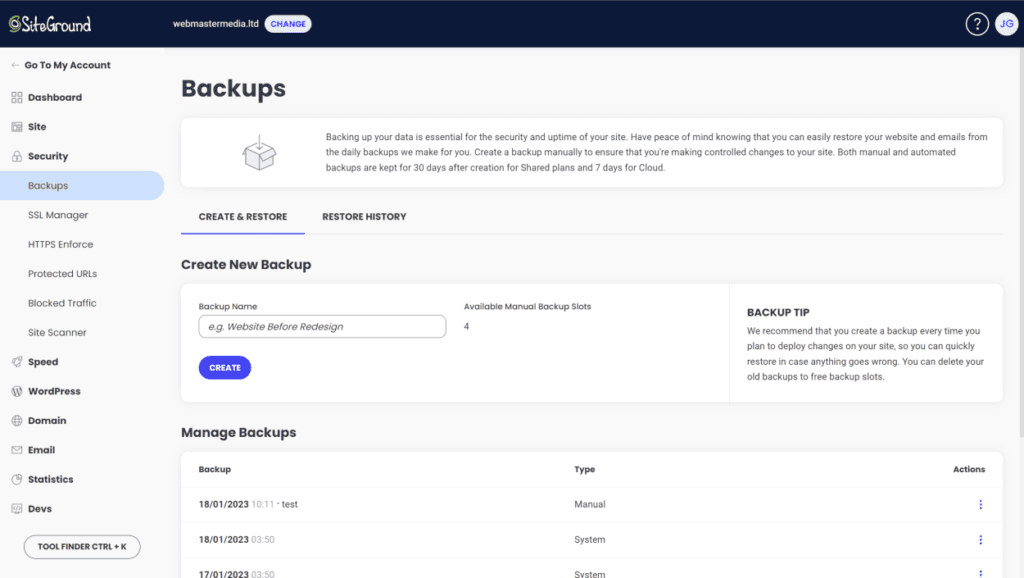
Pros and Cons of Relying on Hosting Provider Backups
Pros
- Automated backup process.
- Restorations are carried out via cPanel.
- Often free with managed WordPress hosting.
Cons
- No off-site redundancy if hardware fails.
- Backups can slow site performance.
- Limited backup retention periods.
- There’s no guarantee the backups are encrypted.
Choosing the Right WordPress Website Backup Method
With the vast options for securing WordPress sites, including plugins, services, and tools offered by hosting providers, selecting the right method for your needs can be quite challenging.
Here are a few things to remember as you decide:
How tech-savvy are you? If servers and coding aren’t your jam, consider user-friendly solutions with simple setups and restores. Plugins or some host-provided tools can be great here.
What’s your budget? Free plugins work for simpler needs. You can also back up WordPress through FTP on a budget. But if you want more custom features, paid plugins with multiple storage options are worth the cost.
What’s your preference? Think through whether you want backup totally within WordPress or through provider-level tools. Most plugins and offsite options complement each other nicely.
Conclusion
Reliably backing up your WordPress site is essential to avoid losing your hard work. Manual backups provide control yet can prove tedious and high-risk.
Most turn to automated plugins or web host backup services for simplicity. While free plugins cover fundamentals, paid versions deliver heightened customization and site restoration assurances.
When assessing backup solutions, examine your budget flexibility, technical confidence, and specific protection needs. If craving full control, manual backups may suit you.
However, for convenient, set-and-forget website security, paid automated options are ideal for most – allowing peace of mind as your content stays safely guarded.